#stribog deity
Explore tagged Tumblr posts
Text

Stribog, Master of the Winds, 2014 - oil on canvas.
— Andrey Alekseyevich Shishkin (Russia, 1960).
Stribog is traditionally considered the bozhich of wind or air. “The Tale of Igor's Polk” informs about the connection of Stribog with the air element: ‘The winds, Stribog's grandsons, blow arrows from the sea to the brave Igor's regiments’.
#slavic culture#slavic folklore#slavic#slavic mythology#slavic polytheism#slavic folk#slavic art#slavs#stribog#stribog deity#Стрибог#Стрибогъ#russian art#folk art#art#artwork#artists on tumblr#modern art#oil painting#paintings#painting#mythology art#not my art#mythology#folklore#mythology and folklore#andrey sishkin
13 notes
·
View notes
Photo
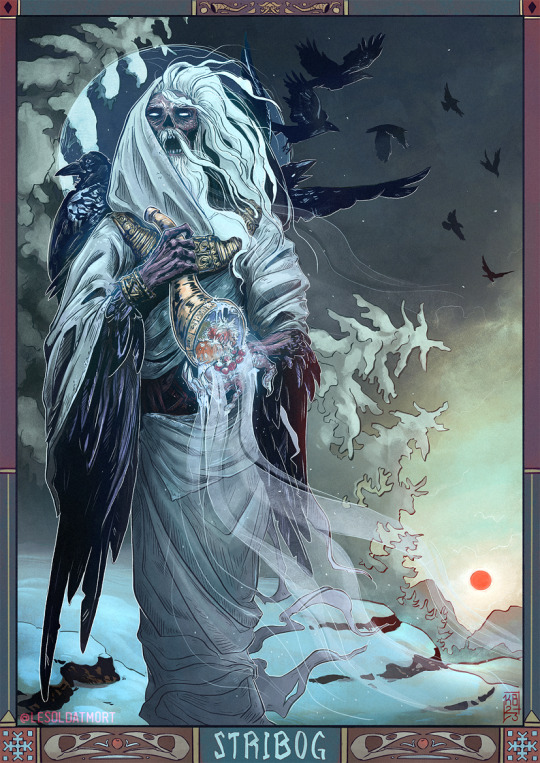
| STRIBOG |
Father of freezing winds who flies through the skies.
Stribog is usually interpreted as a god of winds, especially the cold freezing one which brings death to all living. The murder of crows and ravens around him are his demon servants which sometime tease humans by causing little or bigger accidents, for which we blame the wind.
More (folk)lore, info and WIPs of this project on my P/treon.
#stribog#slavic#slavic folklore#slavic mythology#folklore#folklore art#illustration#slavic deities#digital illustration#digital ink#this one took longer but hey its the end of february and we just got fresh snow accompanied by pretty strong wind so#stribog is still ruling over the skies together with morana it seems
224 notes
·
View notes
Text

Stribog is a mysterious deity of the Slavic pantheon...
#oil painting#valery glotov#russian artists#russian art#artwork#art#artists on tumblr#painting for sale#painting#realism#stribog#slavic deity
1 note
·
View note
Text
Feast of the Sky Gods

What is the Feast of the Sky Gods?
The 15th - 17th of August is a multi path, multi cultural festival to celebrate all sky deities from all over the world. The days are celebrated with feasting, spending time outdoors, cloud watching, and visting or hiking to high places or places that allow you to be in the open air. Good foods for any feast
- Light alcohols (bubbly alcohols, white) - Light fruits (white grapes, physalis fruit) - Light sweets/desserts (unusually, candy floss is a great idea) - Blue, white, pastel coloured foods.
All deities will have their preferred offering, but for a general altar, good items would be - feathers - white blue or pastel candles - white, blue, pastel altar cloths - weather stones - dandelions, sycamore seeds - honey Some gods to honour include - Horus - Nzambi Mpungu - Badessy - Shango - Ataksak - Tzacol - Atahensic - Binbeal - Zhinu - Zojz - Dievs - Nuada - Zeus - Hera - Apollo - Indra - Asman - Uranus - Jupiter - Juno - Aurora - Eos - Stribog - Perun - Izanagi - Ranginui - Ukko (Thank you to Mari who helped me with African and Native American representation in deities)
#pagan#festival#holiday#feast#sky god#sky gods#deities#witch#wiccan#witchcraft#hera#zeus#apollo#horus#jupiter#juno
24 notes
·
View notes
Text
The Slavic Iceberg Explained (Stolen from Reddit, all credit to OP)
1 level
Baba Yaga - famous witch-like entity, that lives in the house on chicken legs. Her features alone are worth the iceberg, but she herself is extremely well-known.
Three bogatyrs - bogatyr is the folk hero in slavic mythology. Most well-known bogatyrs are Ilya of Murom, Dobrynya Nikitich and
Alyosha Popovich, as all three of them are depicted in the famous painting.
Koschei the Deathless (or Kashchei) - the prototype for DnD liches, the immortal sorcerer and/or warrior, whose death is hidden in the needle that is hidden in the egg that is found in the duck that is somehow lives in the hare that is kept in the chest that is chained to an oak that is located on a faraway island. He’s one of the most popular Slavic fairy tale characters.
Leshy - a trickster spirit of forests that can appear in different forms and cause various levels of mischief (typically getting people lost in the woods).
Perun - a chief deity of Vladimir's pantheon, presumably a god of storms and warfare. He is one of the few gods that were mentioned more than once in literary sources, and many scholars suspect some Perun character traits were passed down onto the Slavic version of Elijah the Prophet.
Grandpa Frost (Ded Moroz) - holiday gift-bringer that is very similar to Santa Claus. He was mostly created by the Soviets in the early 20th century, but is also heavily inspired by St. Nicholas and Slavic spirit of winter named Moroz (which means just "Frost").
Zmey Gorynych - "Serpent of the Mountains", a three-headed serpent, an archetypical dragon (much more draconic than actual Western European dragons). He's also a very popular folklore character, but most commonly he's depicted as a nemesis for Dobrynya Nikitich. Zmey kidnaps people, breathes fire and takes care of a whole bunch of little serpent children.
Pushkin's fairy tales - Alexander Pushkin, who's widely regarded as the most famous Russian poet, had something of a phase of fascination with traditional folklore. As such, he wrote a bunch of fairy tales like "a tale about Tsar Saltan and his son Knaz Gvidon", "a Goldfish", "a tale about a Golden Rooster" and some others.
2 level
Primary Chronicle - a chronicle written by a monk named Nestor, that has some details on pre-Christian Slavic Mythology (among many other things). It is also our primary (pun kinda intended) source for the Kievan Rus history studies.
The Tale of Igor's Campaign - an anonymous epic poem written in the Old East Slavic language (allegedly told by the mythical poet Boyan). It details a failed raid of Igor Svyatoslavich (d. 1202) against the Polovtsians of the Don River region. It gives a bit of an insight into the worldview of 11th century Rus' people and mentions a lot of mythological characters like Veles and Khors.
Domovoi - a household spirit, whose attitude towards people can vary from positive to outright hostile. Much like with Baba Yaga, there’s way more tales about Domovoi than I’m able to list here.
Veles ~ Volos - one of the most well-known Slavic deities (or two, if Veles & Volos are somehow different), presumably the god of cattle, trade and arts. Some of his qualities seem to be transferred onto Saint Blaise (because their names are kinda similar) and also onto Saint Nicholas for some reason.
Kolobok - a round piece of bread that came alive for unexplained reasons. It is a character of a popular fairy tale, fairly similar to the gingerbread man.
Vladimir's pantheon - according to the Primary chronicle, Vladimir was a ruler of Kievan Rus who attempted to unify Slavic beliefs by building a big shrine for six deities — Perun, Khors, Mokosh, Dazhdbog, Stribog, Semargl.
Talking animals - magical talking animals (most commonly horses) are often presented as necessary for the folkloric hero to complete an impossible task.
Vladimir, the Red Sun - a very popular character in the bylinas, loosely based on the historical Vladimir. He is commonly depicted as a ruler of Kievan Rus and has an authority over bogatyrs
Nightingale The Robber - an enigmatic nemesis of Ilya of Murom, a robber who possesses the ability to whistle with enough force to uproot trees and instantly kill most people. Some accounts say that Nightingale the Robber belongs to the Mordvin people
"Magical bride" tale format - a very popular Slavic fairy tale plot involves a powerful magical woman and either attempting to win her over or saving her from kidnapping. Sometimes both.
Vodyanoi - the spirit of a river or a lake, who can drown people, commands fish and can require a sacrifice
Self-setting tablecloth - a popular magic item. When you roll this tablecloth over a table, it magically summons food and drink
Imps - little demons are very popular antagonists (and sometimes just creatures doing their thing) in Slavic folklore and can occasionally substitute for other, more neutral spirits
Werewolfs/Volkolak - people, who turn into wolves, are widespread in Slavic mythology. They can be either cursed people or warlocks, shape-shifting by their own free will
Kikimora - a mean little female spirit that causes mischief and ruins the work. In different versions she can be a wife of Domovoi, a spirit of an unborn baby or an animated doll created by a witch.
Fern flower - one of the most famous magical plants. It was believed that ferns blossom only once a year, on Ivan Kupala night. The Fern Flower grants its user many magical abilities like knowledge of hidden treasure locations.
The Turnip - a pretty strange but popular fairy tale about an enormous turnip that grew in an old man's garden one day. To pull this vegetable out, he, his wife and their granddaughter needed the help of their dog, cat and even the little mouse
Buka and Babay - slavic versions of Boogeyman. Babay is sometimes described as an old man, who steals children and puts them in his bag. There are also other names for creatures like these, for example “Hoka”.
Yarila - a personification of a summer holiday, that seems to be a variation of the dying-and-rising deity. Yarila's customary celebration was basically a funeral, where his doll was mourned and buried. However, Yarila was a victim of many mystificators, who referred to him as a god of sun and love.
3 level
Neopaganism - despite having so little info on the actual mythology, Slavic Neopaganism is pretty popular. Unfortunately, many neopagans are also Nazis and/or following conspiracy theories, but there are some people who are actually interested in their culture and work with actual folkloric sources
Sadko - merchant and trickster from Novgorod bylinas. He was abducted by the Sea Tsar but saved himself with the help of Saint Nicholas (or, in some versions, the wife of the Sea Tsar)
Alkonost and Sirin - magical birds with woman heads. Their singing enchants people, making them forget everything and follow the source of the song. They were at least partially based on sirens from Greek mythology (and in Alkonost case - on mythological Alkyon).
Rusalka - the most iconic Slavic undead, unresting spirits of drowned maidens (or just maidens), who hunt people in summer and have a number of unnerving traits. However sometimes they are presented in a positive way — their presence can cause crops to grow better.
Swan-geese - the servants of Baba Yaga in one of the popular fairy tales. They are sentient birds that kidnap children for her.
Bannik - one of the many house-spirits, spirit of banya, traditional slavic bathhouse. He is pretty dangerous and can splash boiling water on someone or cause a heat stroke. However he can also tell the future, if you ask him the right way.
Hoaxes - unfortunately, pseudomythology, misconceptions and blatant lies plague the field of slavic mythology studies. Most notable hoaxes being “The Book of Veles” and “Slavic-Aryan Vedas”.
Svyatogor - a giant bogatyr who lives on the Holy Mountains (which he draws his name from), because in other places Earth just can't hold him. There are a couple of bylinas about him, and in one of them he dies after laying down into the suspiciously appropriately-sized coffin.
The Sea Tsar - a ruler of the sea folk and other sea creatures. He is rarely mentioned in folkloric sources. Sea Tsar's underwater parties cause storms on the sea
Poludnitsa - the Midday Maiden, the spirit of midday and sunstrike. She appears in different forms and can have different behaviors, but most often she attacks and kills those who work during the midday hours
Waters of life and death - artifacts that are often present in fairy tales. Water of death (contrary to its name) turns a disembodied corpse into a whole body, and water of life restores this body back to life
Rod & Rozhanicy - Rozhanicy are the spirits of fate that appear to the newborn baby in groups of three (much like Greek Moiras) and "grant" them their future fate. As such, a mother should follow certain traditions to appease them. Rod was mentioned together with Rozhanicy in some medieval sources, but doesn't seem to survive in more recent traditions, so there had been a lot of speculation about what was his deal.
Tugarin Zmey - an archenemy of Alyosha Popovich, a giant warlord, that may or may not be serpentine in appearance. He throws knives at Alyosha, while flying way up high on “paper wings”. Alyosha prays to the God, who sends a heavy rain, so Tugarin Zmey can't fly anymore and has to face our hero on the ground. Tugarin's name is of unidentified origin.
Witches and Warlocks - very popular characters in Slavic folklore. There are a lot of beliefs about them, and many of them separate "born" and "taught" witches. Though there are good witches and warlocks, most of them use their powers to magically steal others' goods like milk and grain.
Viy - the titular character of Nikolai Gogol's novella with the same name. It is described as a hideous being with long iron eyelids reaching its knees. Viy commands other demons, but this detail seems to be invented by Gogol, as well as its name. However, there are a multitude of characters that share its main characteristic - giant eyelids that they are unable to raise without help.
Upir - East Slavic name for vampire. Warlocks, heretics and people who died unnaturally or weren't properly buried can rise from their graves in the form of blood-sucking malevolent undead.
Bolotnik - the spirit of a swamp, typically a very aggressive creature that lures people deep into the swamp. The swamp was always considered a domain of demonic creatures.
Mother Moist Earth - a very popular deity that isn't mentioned in written texts, but was well-known in folklore even well after the advance of Christianity (although, of course she wasn't called a goddess, just some vague entity). Mother Earth embodies, well, everything connected to nature, like growing crops, and also seems to be the goddess of oathkeeping.
Fiery serpent - a type of doppelganger creatures that take the appearance of a dead or missing husband and feed off the energy of a woman
Mikula Selyaninovitch - the most powerful bogatyr ever, a regular farmer, who can lift the weight of the entire earth in his bag (in text it is referred to as "тяга", which can be translated as "gravitational force"). He's known as the son of Mother Moist Earth and prayed to as a saint.
Polenitsa - a gender-neutral substitute for "bogatyr", that was commonly used to describe a female warrior. Polenitsas are sometimes encountered in bylinas and tend to be stronger and smarter than male warriors
Peresvet and Chelubei - according to legends, Peresvet was an Orthodox monk, who chose to fight Chelubei - a mighty warrior from Golden Horde - during the battle of Kulikovo. Peresvet and Chelubei killed each other, but Peresvet managed to stay in the saddle after being hit by the spear, while Chelubei fell. Peresvet could've been a historical figure, but the battle is but a legend.
4 level
Folk Christianity - this term is used to describe beliefs and practices that exist in folk communities and includes a lot of elements from their original beliefs. Folk Christianity is a very important source of information about pre-Christian mythologies.
Serpent walls - these are huge and ancient fortifications of unclear origin, that span across Ukraine on the right bank of Dniepr and its tributaries. These fortifications are predominantly presented as ramparts of earth, which led to the creation of a legend about a mighty bogatyr (his name can vary) who has harnessed a serpent in a giant plow and furrowed him way to the Black Sea, where the bogatyr drowned his enemy.
Marya Morevna - a titular character of the story about your typical young prince, who fought Koshey and saved the girl. Interesting thing about Marya Morevna is that she A) presented as a mighty warrior and B) Her name sounds suspiciously similar to Marena or Marzhanna - South Slavic holiday character, a personification of winter and, according to some theories, death. If the latter is true, then it explains why Marya Morevna has a rivalry with Koshei the Deathless (although, please take all of this with a grain of salt)
Ripping grass - another magical herb from slavic folklore, a magical grass that supposedly can be used to tear open any door and unearth any treasure
Dove Book - or maybe the Deep Book, it’s pretty unclear. It is an apocryphal book that tells about… well, The Book of Dove, a giant divine book that fell from the sky. Tsar David and Tsar Volotoman arrive to see this phenomenon and engage in the dialog about the origin of the world and important locations and creatures. Despite being clearly Christian, the Book of Dove seems to borrow some elements from original Slavic mythology.
Volots - one of the words for giants in Russian (in Belarus they are called asilki). According to fragmented mentions, volots populated the world before humans, created mountains and rivers, fought serpents and were wiped out by the God himself for trying to fight God or just being generally nasty.
Lihoradka - these creatures are female spirits of disease. They often exist in groups from 7 to 77 and represent different symptoms like fever, muscle pain and jaundice. Sometimes they are said to be cursed daughters of Herod. In modern slavic languages “Lihoradka” translates to “fever”.
Domovoi is the ancestor's ghost - there are a lot of traits in this mythological creature that seems to suggest its original role as a helpful ancestral spirit. Domovoi often has the appearance of the oldest family member. Sometimes it’s even outright stated that the first one who enters a newly built house will become its Domovoi after death.
Chudo-Yudo - a serpentine creature that has multiple heads, but also seems to be human-like in appearance, as it rides a horse and has two pets - a dog and a raven (all three of them can talk). Typically there are three of them, each one stronger than the last. The strongest Chudo-Yudo sometimes possesses a magical ability to regenerate lost heads by touching them with its magic finger.
Different versions of Koshchei - Koshchei isn’t always depicted as Undying. In “Marya Morevna” he doesn’t seem to have immortality and was killed by the magical horse. Some tales use Koshchei’s name to designate another prominent folkloric figure - “a man who’s as tall as the fingernail, but with the beard as long as an arm”. Yeah, he doesn’t have a better name. Finally, bylinas have another Koshchei, who is just some kind of prince without any powers.
Iriy - Iriy or Vyrai is a mythical place where birds, insects and reptiles live in winter (sometimes it is said that birds and snakes have different Iriys). Iriy is said to exist in the West beyond the sea.
Flaming skull - skulls with fiery eyes are decorating the fence around Baba Yaga’s house. In one of the stories, she gives one of these skulls to a girl who helped her. This flaming skull then proceeds to immolate her abusive mother and stepsisters.
Spirits of prosperity - people with magical abilities can obtain a spirit of prosperity, who will steal goods from other people and bring them to its master. Those spirits can take many different forms like little humans, small dragons or black chicken.
Cabinet mythology - “cabinet mythology” is the term in Russian mythological study that designates any pseudomythological element that arises as a result of misinterpretation or deliberate misinformation by researchers. Examples of “cabinet deities” include Lada, Lel and Vesna.
White-eyed Chud - chud is the mythical tribe of the Russian North that fiercely fought colonizers and christianisation. Many of the chud killed themselves or retreated far into the forests. There are a lot of different takes on what chud really is, and this word was also use to designate several actually existing peoples.
Indrik - a giant unicorn-like creature, a king of beasts who lives underwater and uses its horns to dig up rivers. Indrik is mostly mentioned in books like the aforementioned Dove Book
Alatyr - a magical stone, whose power is often called upon in invocations. It is located in the center of the world on the Buyan island in the middle of the sea. Alatyr is considered “a father of all rocks”/
Witcher - Witcher or Vedmak is not that guy from video games and not just a male witch. Witcher has the power over witches and undead and can prevent them from causing harm (or support them). In other aspects vedmaks are pretty much the same as regular warlocks and witches.
The Slavic Iceberg

87 notes
·
View notes
Text
Russian Fairy Tales Test Prep: Pagan Deities
The best known roster of pagan deities is that of the six whose statues Prince Vladimir erected upon assuming sole rule of Kiev. According to the Primary Chronicle for the year 980, he “placed idols on a hill, outside the palace yard, a wooden Perun with a silver head and a golden mustache, and Khors and Dazhbog and Stribog and Simargl and Mokosh.” Missing from this list is Volos/Veles, the god of cattle (skotnii bog) and commerce, whose veneration in ancient Rus’ is widely attested, and by whose name (along with that of Perun) ancient Russians ratified oaths.
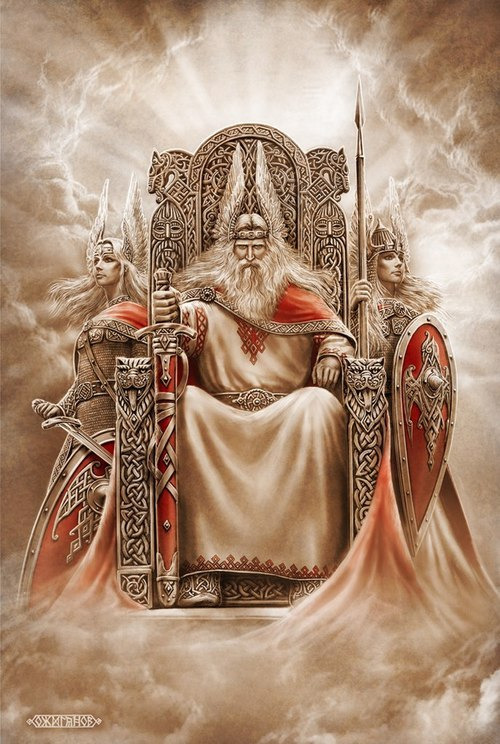
A. Perun/Bog
1. equivalent to: Lithuanian Perkunas, Latvian Perkons, Albanian Perendi, Roman Jupiter, Greek Zeus, Hittite Teshub, Norse Thor/Donar, Celtic Taranis. 2. primary sources: Nestor’s Chronicle, mid-6th century Procopius, 10th-century Varangian treaties 3. primary story: a creation myth, in which he battles Veles, the Slavic god of the underworld, for the protection of his wife (Mokosh, goddess of summer) and the freedom of atmospheric water, as well as for the control of the universe. 4. dvoeverie: After Christianization in the 11th century CE, Perun's cult became associated with St. Elias (Elijah), also known as the Holy Prophet Ilie (or Ilija Muromets or Ilja Gromovik), who is said to have ridden madly with a chariot of fire across the sky, and punished his enemies with lightning bolts.
In Slavic mythology: Perun was the supreme god of the pre-Christian Slavic pantheon, although there is evidence that he supplanted Svarog (the god of the sun) as the leader at some point in history. Perun was a pagan warrior of heaven and patron protector of warriors. As the liberator of atmospheric water (through his creation tale battle with the dragon Veles), he was worshipped as a god of agriculture, and bulls and a few humans were sacrificed to him. In 988, the leader of the Kievan Rus' Vladimir I pulled down Perun's statue near Kyiv (Ukraine) and it was cast into the waters of the Dneiper River. As recently as 1950, people would cast gold coins in the Dneiper to honor Perun.
Appearance & Reputation: Perun is portrayed as a vigorous, red-bearded man with an imposing stature, with silver hair and a golden mustache. He carries a hammer, a war ax, and/or a bow with which he shoots bolts of lightning. He is associated with oxen and represented by a sacred tree—a mighty oak. He is sometimes illustrated as riding through the sky in a chariot drawn by a goat. In illustrations of his primary myth, he is sometimes pictured as an eagle sitting in the top branches of the tree, with his enemy and battle rival Veles the dragon curled around its roots.
Perun is associated with Thursday—the Slavic word for Thursday "Perendan" means "Perun's Day"—and his festival date was June 21.
Reports: The earliest reference to Perun is in the works of the Byzantine scholar Procopius (500–565 CE), who noted that the Slavs worshipped the "Maker of Lightning" as the lord over everything and the god to whom cattle and other victims were sacrificed.
Perun appears in several surviving Varangian (Rus) treaties beginning in 907 CE. In 945, a treaty between the Rus' leader Prince Igor (consort of Princess Olga) and the Byzantine emperor Constantine VII included a reference to Igor's men (the unbaptized ones) laying down their weapons, shields, and gold ornaments and taking an oath at a statue of Perun—the baptized ones worshipped at the nearby church of St. Elias. The Chronicle of Novgorod (compiled 1016–1471) reports that when the Perun shrine in that city was attacked, there was a serious uprising of the people, all suggesting that the myth had some long-term substance.
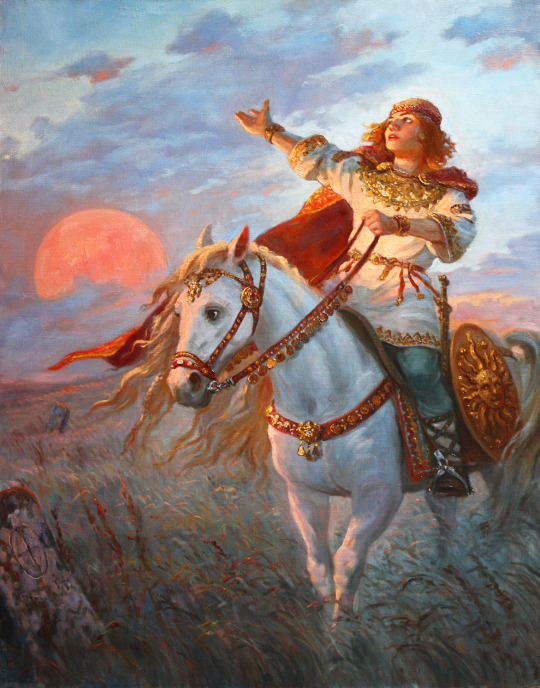
B. Kors/Xors/Chors
- most frequently mentioned Slavic god, after Perun - dvoeverie: appears in the apocryphal work Sermon and Apocalypse of the Holy Apostles, which mentions Perun and Khors as old men; Khors is said to live in Cyprus. Khors also appears in the apocryphal text Conversation of the Three Saints, a text which combines Slavic + Christian + Bogomil traditions. In it, he is referred to as “an angel of thunder” and it is said that he is Jewish. - his functions are uncertain and there are multiple interpretations of his name.
1. Sun God hypothesis: associated with Dazhbog; in The Tale of Igor’s Campaign, Prince Vseslav, who “came to Tmutarakani before the cocks" and "Khors ran his way", traveled from west to east and thus reached the castle before the cocks crowed, and in this way "overtook" the Sun; his name means “rays.”
2. Moon God hypothesis: Prince Vseslav was called “wolf” and his journey takes place at night when the sun is absent from the sky; his name does mean “rays” but they’re the moon’s rays and not the sun’s rays.
3. Fertility God/Vegetation hypothesis: link between Thracian & early Slavic cultures indicates Kors is more of a Dionysus-type figure, who dies and is risen; like Dionysus, Dazhbog (who Kors is often linked to) has a double nature (Eastern Slavs assign him solar qualities, while Southern Slavs assign him chthonic qualities).
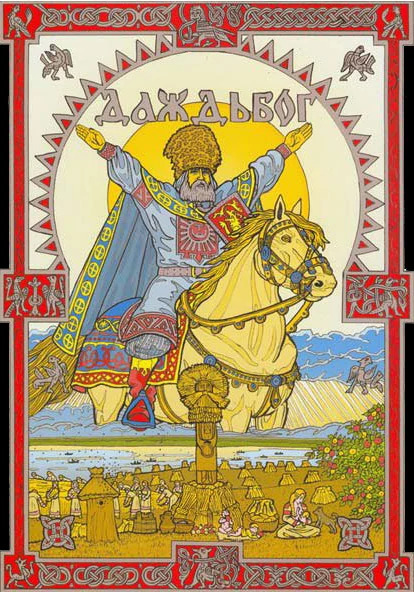
C. Dazhbog
1. equivalent to: Khors (Russian/Iranian), Mithra (Persian), Helios (Greek), Lucifer (Christian) 2. primary sources: John Malalas, The Song of Igor’s Campaign 3. family: Son of Svarog, brother of fire god Svarozhich, husband of Mesyats (the moon), father of the Zoryi and Zvezdy 4. primary myth: He resided in the east, in a land of everlasting summer and plenty, in a palace made of gold. The morning and evening auroras, known collectively as Zorya, were his daughters. In the morning, Zorya opened the palace gates to allow Dazbog to leave the palace and begin his daily journey across the sky; in the evening, Zorya closed the gates after the sun returned in the evening. 5. dvoeverie: There was a belief that each winter he would enter people's homes and gift gold to those who had been good. That belief passed into Christianity, especially in Serbia, and this visitor was called Položajnik. During Christianisation, his cult was exchanged with the cult of Saint Sava, while Dažbog became lame Daba - the most powerful demon in Hell. Reasons why he was demonized are various, possibly because his cult was the strongest in Serbia or because he was considered also as the god of Nav, the Slavic underworld and world of the dead.
In Slavic mythology: Dazbog was the Slavic sun god, a role that is common to many Indo-European people, and there is ample evidence that there was a sun cult in the pre-Christian tribes of central Europe. His name means "day god" or "giving god," to different scholars—"Bog" is generally accepted to mean "god," but Daz means either "day" or "giving."
His totem animal was a wolf, therefore wolves were sacred animals and killing them was considered a great sin. Wolves were considered to be messengers of Dazhbog, while he himself could shift into a white wolf.
According to one myth, Svarog became tired of reigning over the universe and passed on his power to his sons, Dazhbog and Svarogich.
Appearance & Reputation: Dazbog is said to ride across the sky in a golden chariot drawn by fire-breathing horses who are white, gold, silver, or diamonds. In some tales, the horses are beautiful and white with golden wings, and sunlight comes from the solar fire shield Dazbog always carries with him. At night, Dazbog wanders the sky from east to west, crossing the great ocean with a boat pulled by geese, wild ducks, and swans.
In some tales, Dazbog starts out in the morning as a young, strong man but by the evening he is a red-faced, bloated elderly gentleman; he is reborn every morning. He represents fertility, male power, and in "The Song of Igor's Campaign" he is mentioned as the grandfather of the Slavs.
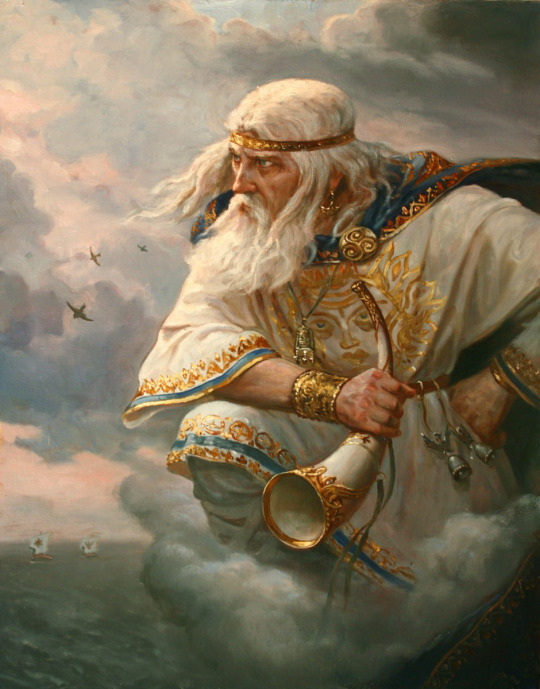
4. Stribog
Very little is known about him, although he was clearly very important to early Slavic peoples. In the epic ”Slovo o polku Igorove “ it is said that the winds, the grandsons of Stribog, blow from the sea. This leads to conclusion that Stribog is imagined as an old person, since he has grandsons. The grandsons were the winds from all directions.
Eagle was the animal consecrated to Stribog. Plants consecrated to Stribog were hawthorn and oak. When pledges were made, Stribog was often warrantor. Festivities in Stribog’s honor were organized in the summer as well as in the winter. They were probably organized in the summer in order to invocate winds and rain, while in the winter they were organized in order to appease him. In the period of Christianization Stribog’s characteristics were overtaken by St. Bartholomew and Stevan vetroviti (windy).
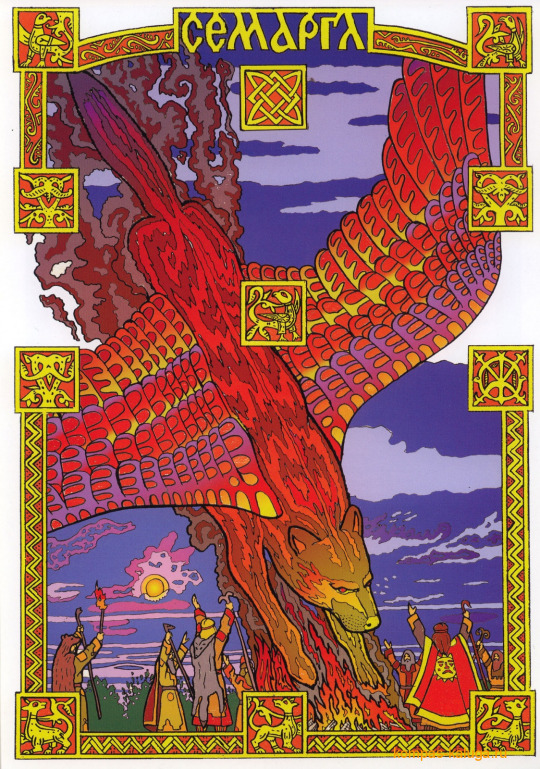
5. Simargl/Semargl
- may be equivalent to Simurgh in Persian mythology, who is portrayed similarly (winged lion and/or dog). He can also take human form. - God of physical fire (as opposed to celestial fire; that’s Svarog) - He is said to be the husband of Kupalnica (or Kupalnitsa), goddess of night, from whom he got two children: Kupalo and Kostroma.
Zorya, solar goddesses who are servants or daughters of the deity Dazhbog, keep Simargl chained to the star Polaris in the constellation Ursa Minor. Should he break free and destroy this constellation, it will cause the world to end.
Why would he be worshipped in Rus’, you ask? A couple of possible answers: a. Eastern Slavs borrowed Simargl from Sarmatian-Alanian people and worshiped him. b. Eastern Slavs never worshiped Simargl. Just at that time, a significant number of Kiev residents were of Khazar and Sarmatian-Alanian origin. Vladimir included their deity in the pantheon to get their support.

6. Volos/Veles (also Vlas, Weles Vlasii, St. Blaise, or Blasius)
1. equivalent to: Velinas (Baltic), Varuna (Vedic), Hermes (Greek), Odin (Norse) 2. primary sources: The Tale of Igor’s Campaign, old Russian chronicles 3. primary myth: a creation myth, in which Veles abducts Mokosh (the Goddess of Summer and consort of Perun, God of Thunder). Perun and his enemy battle for the universe under a huge oak, Perun's holy tree, similar to both Greek and Norse (Yggdrasil) mythologies. The battle is won by Perun, and afterward, the waters of the world are set free and flowing. 4. dvoeverie: Velia remains a feast of the dead in old Lithuanian, celebrating the border between the world of the living and the world of the dead, with Veles operating as a role of guiding souls to the underworld. The battle between Perun (Ilija Muromets or St. Elias) and Veles (Selevkiy) is found in many different forms, but in later stories, instead of gods, they are complementary figures separated from one another by a furrow plowed by Christ, who converts them. Veles is also likely represented by St. Vlasii, depicted in Russian iconography as surrounded by sheep, cows, and goats.
In Slavic mythology: A second creation myth associated with Veles is the formation of the boundary between the underworld and the human world, a result of a treaty forged between Veles and a shepherd/magician.
In the treaty, the unnamed shepherd pledges to sacrifice his best cow to Veles and keep many prohibitions. Then he divides the human world from the wild underworld led by Veles, which is either a furrow plowed by Veles himself or a groove across the road carved by the shepherd with a knife which the evil powers cannot cross.
Veles is associated with a wide variety of powers and protectors: he is associated with poetry and wisdom, the lord of the waters (oceans, seas, ships, and whirlpools). He is both the hunter and protector of cattle and the lord of the underworld, a reflection of the Indo-European concept of the netherworld as a pasture. He is also related to an ancient Slavic cult of the deceased soul; the ancient Lithuanian term "welis" means "dead" and "welci" means "dead souls."
Appearance & Reputation: Veles is generally portrayed as a bald human man, sometimes with bull horns on his head. In the epic creation battle between Velos and Perun, however, Veles is a serpent or dragon lying in a nest of black wool or on a black fleece beneath the World Tree; some scholars have suggested he was a shape-shifter. In addition to domestic horses, cows, goats, and sheep, Veles is associated with wolves, reptiles, and black birds (ravens and crows).
Reports: The earliest reference to Veles is in the Rus-Byzantine Treaty of 971, in which the signers must swear by Veles' name. Violators of the treaty are warned of a menacing punishment: they will be killed by their own weapons and become "yellow as gold," which some scholars have interpreted as "cursed with a disease." If so, that would imply a connection to the Vedic god Varuna, also a cattle god who could send diseases to punish miscreants.
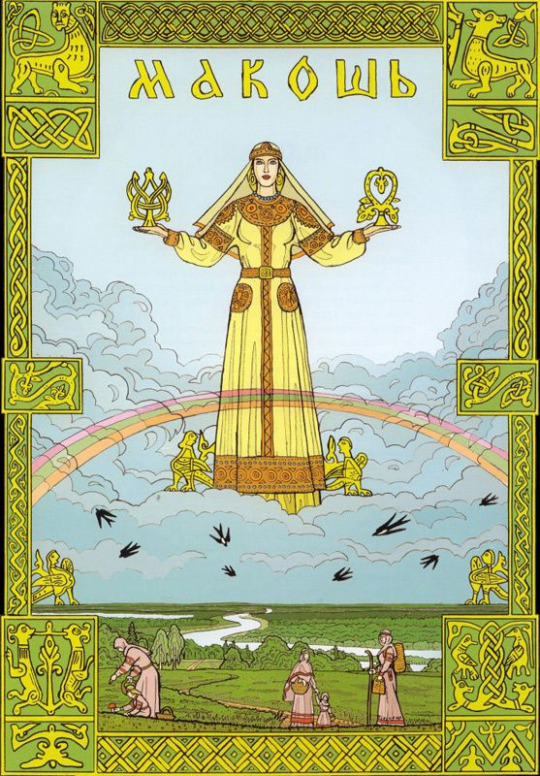
7. Mokosh
1. loosely comparable to: Gaia, Hera (Greek), Juno (Roman), Astarte (Semitic) 2. epithets: Goddess Who Spins Wool, Mother Moist Earth, Flax Woman 3. primary sources: Nestor Chronicle (a.k.a. Primary Chronicle), Christian-recorded Slavic tales 4. dvoeverie: With the coming of Christianity into the Slavic countries in the 11th century CE, Mokosh was converted to a saint, St. Paraskeva Pyanitsa (or possibly the Virgin Mary), who is sometimes defined as the personification of the day of Christ's crucifixion, and others a Christian martyr. Described as tall and thin with loose hair, St. Paraskeva Pyanitsa is known as "l'nianisa" (flax woman), connecting her to spinning. She is the patroness of merchants and traders and marriage, and she defends her followers from a range of diseases.
In Slavic mythology: The origins of Mokosh as mother earth may date to pre-Indo-European times (Cuceteni or Tripolye culture, 6th–5th millennia BCE) when a near-global woman-centered religion is thought to have been in place. Some scholars suggest she may be a version of Finno-Ugric sun goddess Jumala.
Mokosh, sometimes transliterated as Mokoš and meaning "Friday," is Moist Mother Earth and thus the most important (or sometimes only) goddess in the religion. As a creator, she is said to have been discovered sleeping in a cave by a flowering spring by the spring god Jarilo, with whom she created the fruits of the earth. She is also the protector of spinning, tending sheep, and wool, patron of merchants and fishermen, who protects cattle from plague and people from drought, disease, drowning, and unclean spirits.
Although the Great Goddess has a variety of consorts, both human and animal, in her role as a primary Slavic goddess, Mokosh is the moist earth goddess and is set against (and married to) Perun as the dry sky god. Some Slavic peasants felt it was wrong to spit on the earth or beat it. During the Spring, practitioners considered the earth pregnant: before March 25 ("Lady Day"), they would neither construct a building or a fence, drive a stake into the ground or sow seed. When peasant women gathered herbs they first lay prone and prayed to Mother Earth to bless any medicinal herbs.
Appearance & Reputation: Surviving images of Mokosh are rare—although there were stone monuments to her beginning at least as long ago as the 7th century. A wooden cult figure in a wooded area in the Czech Republic is said to be a figure of her. Historical references say she had a large head and long arms, a reference to her connection with spiders and spinning. Symbols associated with her include spindles and cloth, the rhombus (a nearly global reference to women's genitals for at least 20,000 years), and the Sacred Tree or Pillar.There are many goddesses in the various Indo-European pantheons who reference spiders and spinning. Historian Mary Kilbourne Matossian has pointed out that the Latin word for tissue "textere" means "to weave," and in several derivative languages such as Old French, "tissue" means "something woven." The act of spinning, suggests Matossian, is to create body tissue. The umbilical cord is the thread of life, transmitting moisture from the mother to the infant, twisted and coiled like the thread around a spindle. The final cloth of life is represented by the shroud or "winding sheet," wrapped around a corpse in a spiral, as thread loops around a spindle.
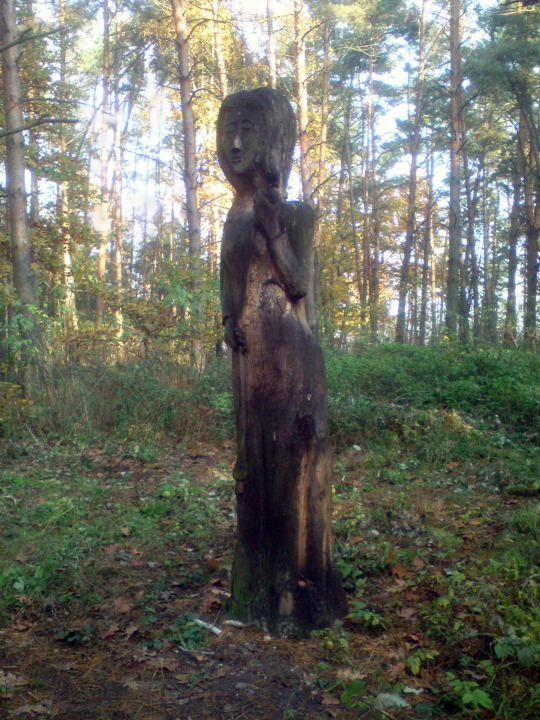
Our brief survey of agrarian holidays indicates that the peasant’s central concern is fertility and that special rites in the cemetery and/or rites involving a symbolic death & resurrection are a major component in these celebrations.
Belief in the absolute sanctity of “Mother Damp Earth” (Mat’syra zemlia) has been central to folk belief throughout the centuries. In remote areas, old people observed a ritual of asking the earth’s forgiveness prior to death into the 20th century. A number of scholars have maintained that peasants transferred attributes of earth worship to their particular veneration of Mary as “Mother of God.”
Fedotov: “At every step in studying Russian popular religion, one meets the constant longing for a great divine female power, be it embodied in the image of Mary or someone else. Is it too daring to hypothesize, on the basis of this religious propensity, the scattered elements of the cult of a Great Goddess who once...reigned upon the immense Russian plains?”
#Russian fairy tales#study blog#my notes#Slavic deities#slavic mythology#Russian paganism#russian folk belief
122 notes
·
View notes
Photo

Stribog is a god in Slavic mythology, often interpreted as a wind deity.
13 notes
·
View notes
Note
Hiii, i was always confused as to how many Slavic gods were there. I know there are perun, veles and morana but these are the only ones that i can find referenced everywhere. I also know that not every single god has been an actual pre-christianity god (like chernobog and belebog). So i was wondering whether you have any precise answer? :)
I do not, and neither does anyone.
Perhaps one precise listing that exists is within the Primary Chronicle, "Vladimir then began to reign alone in Kiev, and he set up idols on the hills outside the castle with the hall: one of Perun, made of wood with a head of silver and a mustache of gold, and others of Khors, Dazh'bog, Stribog, Simar'gl, and Mokosh"
This is a list of idols set up by one ruler in one place. It does not mean that this is all who was venerated, it does not mean that people venerated all of them. Given Vladimir the Great's tendency towards tailoring religion to fit his political purposes, which later is concluded in conversion to Byzantine Christianity, it is unlikely that the actual practices were particularly ordered.
Other sources strongly suggest that not only various tribes had differing religious beliefs, but also that many of them were particularly known for their veneration of one or another deity. In its turn, it does not mean they were monotheistic, but rather that the ideas of divine patronage and holy sites were widely incorporated.
In approaching the subject one must understand that there were never Slavic people with homogenous culture or religion. The conversation is about separate tribes that take up half of a continent and intermingle with a wide variety of other cultures. Ergo, anyone who suggests any defined lists without disclaimers about sources, locations, or personal practice is likely to either be misinformed or purposefully spreading misinformation.
28 notes
·
View notes
Text
Thanks for the tag!
Who, if anyone, was the first deity(s) you worked with?
About 5 years ago, it was Mokosh, the slavic goddess of weaving, sewing, fertility, women and women's destinies.
Who, if anyone, is the deity(s) you’re working with now?
Mokosh, again, and also: Perun and Dajbog. I also pray to Vesna and Morana, and occasionally Stribog.
What’s your favorite aspect of your practice? (Ex: doing tarot, celebrating holidays, casting spells, etc)
Probably prayer and communicating with the gods!
What’s something you want to get better at?
Understanding the gods and how my relationship with them can be!
Tags:
@tengritexas @lunardana @suxevil @sillysybilsden
(sorry if you don't wanna be tagged 👉👈🥲))
I’m starting a tag game!
People are always saying they need more witchy/pagan mutuals so I thought this would be a fun way to find them while getting to talk about your practice!
Who, if anyone, was the first deity(s) you worked with?
Hermes was the first deity that I made the conscious decision to worship though I had always been drawn to paganism. I made a tiny altar, devotional drawings, playlists, and a journal to him. I quickly added Athena and Apollo after that, but it became too overwhelming, and I got burnt out. I stopped practicing for about four years until I started again this year.
Who, if anyone, is the deity(s) you’re working with now?
Artemis was the one who reached out to me this time. She had been sending me a bunch of incredibly obvious signs that took me abt six months to finally notice (my bad lol) but I'm very happy with her now. Athena has also been more present, whereas she was more in the background the first time I tried Hellenism, and now she sits with me at work. Hermes dips in and out and Apollo's the one who's been more in the background. I would like to strengthen my relationship with them because I miss them.
What’s your favorite aspect of your practice? (Ex: doing tarot, celebrating holidays, casting spells, etc)
I like getting things for my altar. It makes me so happy knowing that my gods will like whatever I'm getting; I love getting presents for ppl I care abt. I haven't collected everything into one central altar yet but I'm very excited for when I do.
What’s something you want to get better at?
I want to get better at tarot. I've been doing it for a few years now but I'm still 100% reliant on the guidebook the cards came with and am not very good at making my own interpretations. I'm hoping I'll get better at it with time but it has been quite a while...
Tagging: @buriedpentacles @kore-siciliana @anne-the-witch-ish @serpent-among-vines @khaire-traveler @princesmeadow @hunters-moonlight-serenade @huntingkyrie
187 notes
·
View notes
Text
Gods of ancient slavs: Perun and his imaginary friends
Let's deal with what gods in Ancient Rus' were, and what were not.

The gods of pagan nations are a rich and interesting topic. Their images, in some ways unique, and in some ways similar in different nations, inspire many modern authors. Including in the genres of fantasy, sci-fi, and magic realism.
Back in the 19th century, attempts were made throughout Europe to reconstruct ancient beliefs and understand what gods were worshipped by ancestors. And, of course, the myths of ancient Greece were taken as a model.
The only thing is that we were usually talking about non-written cultures, which left behind very few sources. And if the Scandinavians, for example, had the Eddas, written down already by Christians, but quite early, as well as inscriptions carved in stone, then with the Eastern Slavs everything did not work out so well. We have no recorded epic stories about the gods, and we have to rely on fragmentary evidence in chronicles and denunciations against the pagans, as well as scanty archaeological data. That is why there is so much speculation and outright fiction about the gods of the Eastern Slavs.
In this text, let's try to figure out what we really know about them, what we can assume, and what is quite far from the truth.
The Pantheon of Knyaz Vladimir
The most famous source of information about the gods worshipped in Ancient Rus is the enumeration of idols installed by Knyaz Vladimir in Kyiv, from the "Tale of Bygone Years":
"And began to reign Vladimir in Kyiv alone, and put idols on the hill, outside the palace yard: wooden Perun with a silver head and golden whiskers, Khors (and) Dazhbog, Stribog, Simargl and Mokosh."

Vladimir puts idols of gods in Kyiv. Late 15th c. Radziwillov Chronicle, Library of the Academy of Sciences, St. Petersburg
It should be kept in mind that Vladimir pursued quite specific goals: he tried to unite Rus around Kyiv through a single set of beliefs. That is, it would be wrong to say that the erected idols are an exhaustive list of gods or that all popular gods got there. For example, we are talking, apparently, about Slavic gods, and on the territory of ancient Rus lived also Finno-Ugrians, Turks, Balts.
In addition, it is important to understand that any paganism (even Greek) at the level of practice looks not as the veneration of a once and for all definite pantheon, but as the worship of numerous local deities - patrons of rivers, hills, forests, cities. People turned to them for any reason: for good luck in war, for a rich harvest, and for protection from evil forces. Different gods could merge in one area, and in another, on the contrary, one god was divided into two characters or more.
We do not know on what principle idols were selected in Kyiv. For example, Veles (Volos), often found in other sources, is not mentioned among them. In addition, the "Tale of Bygone Years" was preserved in lists XIV-XVI, not in the original, and the lists were often made with errors. And Nestor did not aim to accurately convey the pagan ideas. But we have what we have - there is nothing to choose from.
So what do we know about the 5 (or 6) gods mentioned in the Tale?
Perun
We know relatively much about Perun. He is often mentioned in various sources, he was worshipped by the Western Slavs, about whose customs we know a little more. He is also close to the Baltic Perkunas, and many of his features and related legends were attributed to Ilya the Prophet and remained in this form until the Revolution.
Perun is a thunder god. The very word "Perun" in Russian, Ukrainian and Belarusian is used as an obsolete and poetic name for lightning. This was an important god for the inhabitants of Ancient Rus, commonly known and honored. He may well be considered the supreme god, if it is necessary to emphasize such a figure. The Byzantine Procopius of Caesarea wrote back in the 6th century that the Slavs (it was about the South Slavs) above all venerate an unnamed thunder god to whom they sacrifice bulls. The connection of Perun with warriors and militancy, oaks, weapons - all this is characteristic of the gods-thunderers - looks quite plausible.
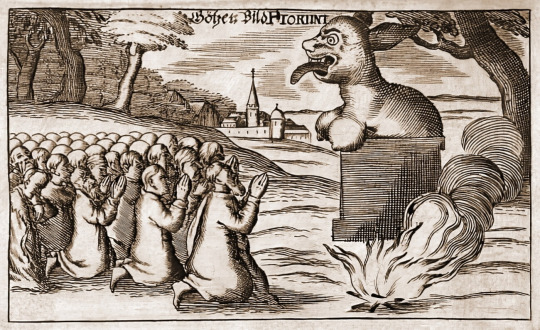
Worship of Perun among the Muscovites. Engraving from the book by G. A. Shleizing "Ancient and New Religion of the Muscovites", 1698
Later sources mention rituals in honor of Perun. For example, Novgorod fights were described, which were associated with the commemoration of Perun. There is also a mention of the rafting of Perun's idol down the river, similar to the description of the overthrow of his idol from the Tale of Bygone Years. Some researchers suggest that the chroniclers simply incorrectly conveyed the regular ritual. The motif of such funeral-conductions is rarely associated with thunder gods, it is more characteristic of the gods of the sun and fertility. This may mean that Perun had such functions as well.
Various assumptions about Perun's family ties, specific features of his veneration, sacrifices, temple construction, etc. should be treated with caution: they are based on controversial scientific data.
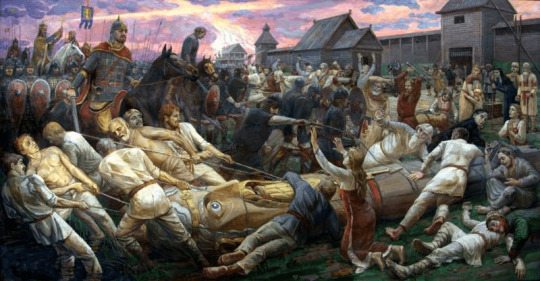
The overthrow of the idol of Perun in the painting "The Trampling of Old Russian Gods" by E. Shtyrov
But one can look at the peculiarities of popular veneration of the "formidable saint" Elijah the Prophet. His image began to converge with Perun even before the official baptism of Russia, as pagan and Christian legends converged (such a merger is more than characteristic of the pagan picture of the world). Most likely, this is what made Ilya one of the most revered saints in Rus'.
It was believed that the prophet rode across the sky on a golden or fiery chariot and struck devils and various creeps with lightning arrows. In some regions it was believed that Elijah should pray in a thunderstorm all the time, so that a demon would not enter a person, because then the prophet would strike him with lightning. Caution should be observed on Ilya's day at the end of the harvest (August 20): on this day it was forbidden to work in order not to anger the saint. In addition to striking devils and people with lightning, Ilya also sent down rain and drought. These legends about the saint probably go back to the image of Perun.
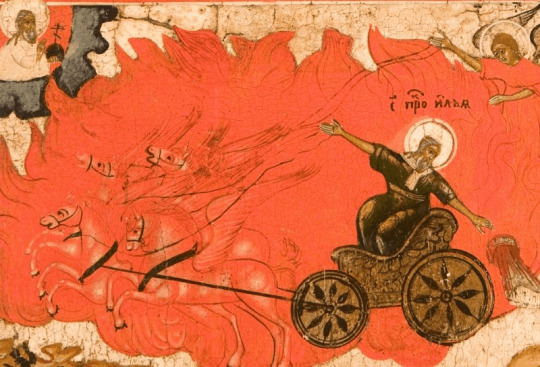
Elijah the Prophet on his chariot
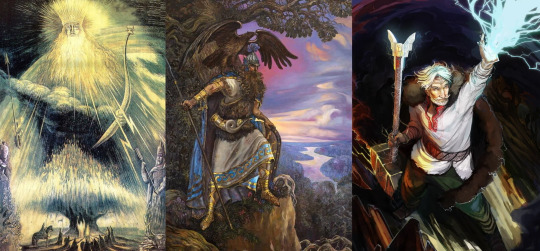
Various Peruns by lugvelesasrz, A. Klimenko, Mikado13
Mokosh-Makosh

Makosh by Viktor Korolkov
Mokosh is the only female goddess in Knyaz Vladimir's pantheon.
The romanticist researchers largely invented her cult from the folk veneration of St. Paraskeva Pyatnitsa, associated with weaving and needlework. From weaving made the transition to the threads of life, and Mokosh turned into the goddess of fate. The problem is that unlike Perun and the prophet Elijah, we do not know anything about Mokosh at all, except that she was a woman. For example, we have no data that she was depicted with a spinning wheel. So there is simply nothing to draw parallels between her and Paraskeva.
Sometimes the figure of Mokosha is brought closer to such a folklore character as Mother raw earth. This is a common image in bylinas and fairy tales, and we can conclude that in the Slavs' ideas the earth occupied a very important place. But it is hardly worth talking about the personification of the earth in the form of a goddess. Most likely, the earth as a living element was meant, which reminds ancient religious ideas, for example, the Chinese. However, it is possible to correlate Mokosh with Mother raw earth. This is much less of a stretch than many other theories about the Slavic gods.
Who else could be the only goddess included in the new unified pantheon? For example, the goddess of women, patroness of childbearing and women's crafts. Or the goddess of fertility, possibly acting as wife of Perun. Or maybe a warrior goddess like Ishtar, the embodiment of power and luck in battle. Such a woman could well be on the princely hill, where, judging by the "Tale" did not take the "cattle god" Volos, despite his great importance. Historical data in no way limit the flight of our imagination.

Mokosh by BirnaAlicja
Khors-Dazhbog
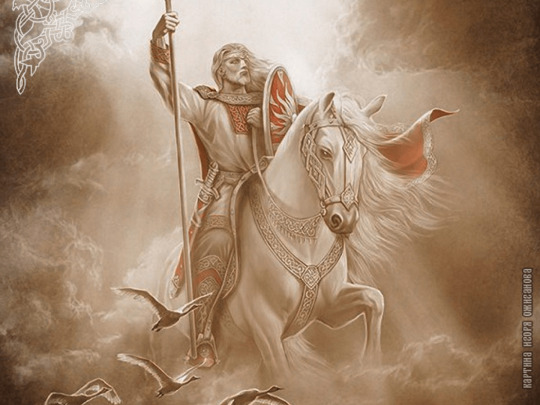
Khors by Igor Ozheganov
The further things are worse. Between the names of Khors and Dazhbog in the "Tale" there is no union, but between the other names there is. This may be a reproduced mistake of the scribe. Or it may be an indication that these are two names of the same god (Khors-Dazhbog). In other sources both gods appear separately, but are never mentioned together.
In the "Conversation of the three saints" there is such an answer to the question where lightning comes from: "There are two thunder angels: the Hellenic elder Perun and Khors the Jew - these are the two angels of lightning". What it means and why these national epithets - who can tell. Some researchers believe that this is an indication that the cult of Khors came to Russia from the Jewish Khazaria, but this is a controversial statement.

Khors by Andrey Shishkin
There are also questions with lightning. This is the only mention of Khors with its functions. But there is a popular theory about the etymological connection of Khors with the Iranian-language root "khur", "khvar", meaning "sun". Linguists dispute this point of view, but so far it remains dominant, and the idea of connection of Khors with lightning, which does not fit into this concept, is often rejected.
In the "Tale of Igor's Campaign" there is an ambiguous phrase: "in the night trotting wolf: from Kyiv to Tmutorokan kurs, to the great Hrsovi the way was broken". Interpreting "Hrsovi" as "Khorosovu", romantically inclined researchers conclude that the "Khors' way" and consisted in "trotting wolf". And so Khors was actually connected with wolves, werewolfism and acted as a dark god of wild beasts and witchcraft. But it should be remembered that the only direct indication of Khors' functions is connected with lightning, and in the "Tale" it is quite possible that he was not meant at all.
In short, the god Khors was, but what he was doing - we will never know.
And what about Dazhbog? Let's see what Wikipedia calls the most informative source about him - "Chronography" by the Byzantine John Malala. He wrote, however, about the Egyptians, and the name Dazhbog was used to translate the name of the sun god Helios mentioned there, which in turn symbolized Amon Ra. From this we can conclude with some tension that the translator associated Dazhbog with the sun god. Also the word "Dazhbog" is mentioned in Ukrainian songs, including as the one who ends winter and begins summer. This also confirms the solar version.
In "The Tale of Igor's Campaign" knyazs or all Rus' people are called "Dazhbog's grandsons". Although there are different opinions about what this means, perhaps it is about the fact that Dazhbog was perceived as the forefather, the god-grandfather of the nation or humans in general.
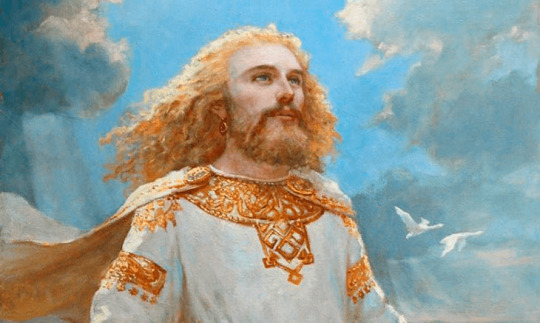
Dazhbog by Andrey Shishkin
Stribog
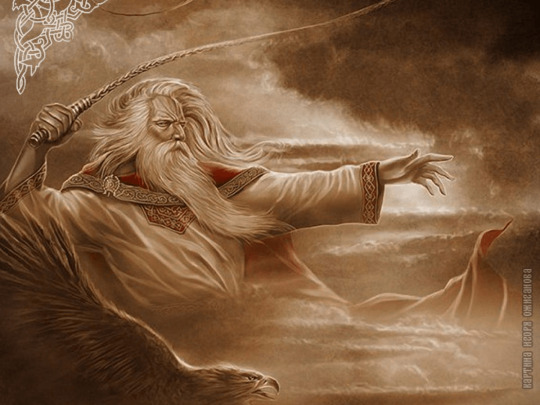
Stribog by Igor Ozheganov
Stribog is another character about whom we know nothing. Practically the only mention - in "The Tale of Igor's Campaign" it is said about the winds as "Stribog's grandsons", who direct arrows against Igor's army. On the basis of this not even a passage, but a sentence, theories were built that Stribog is the god of winds, as well as an evil god, an opponent of men, who was opposed to Dazhbog (mainly because both words are arranged in the same way).
From here went the identification of Stribog with St. Kasyan - a very curious character of folk Orthodoxy, evil, hostile, crooked (oblique) in one eye, guarding hell and sending winds and diseases. Kasyan deserves a separate story, but the grounds for his correlation with Stribog are very shaky.
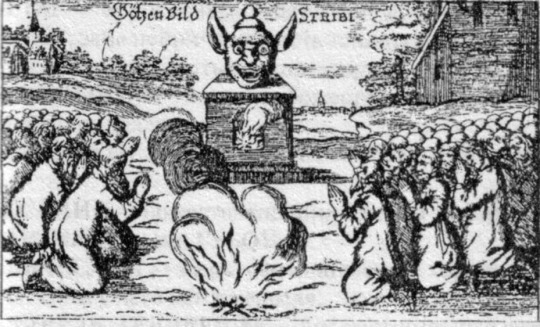
Worship of Stribog at the Muscovites. Engraving from the book by G. A. Shleizing "Ancient and New Religion of the Muscovites", 1698
Simargl

Semargl by V. Korolkov
And the most mysterious character of Vladimir's pantheon is Simargl. In the "Word of a certain Christ-lover and zealous for the right faith" there is a quote: "believe… in Sim and in Rjgl (Erjgl)". But in other manuscripts Simargl or Semargl is written in one word. Who this person or persons were, what they did, is unknown. At some point his name was correlated with the Iranian Simurg on the basis of the similarity of the words. Simurgh is a mythical king-bird whose image probably (probably!) derived from Senmurv, a half-bird half-dog. The odious researcher Rybakov suggested that it was the half-bird-half-dog that stood on the hill in Kyiv, that he was the messenger of the gods, and was also associated with fertility and much more. All this does not stand up to criticism from a scientific point of view.

Simargl by Irdeorum-III
Who wasn't taken to the hill?
Volos / Veles
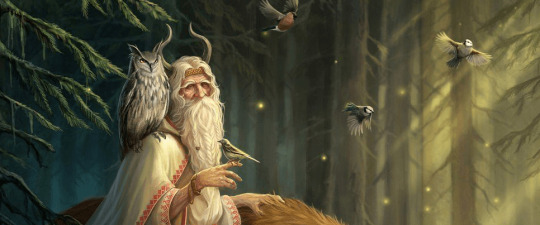
Veles by baklaher
Volos, judging by frequent references in sources, was a popular god of Ancient Rus. His name was sworn along with the name of Perun. He is often called the "cattle god", i.e. the patron of cattle, and therefore of wealth. That is, we even know what functions he had.
"The Tale of Bygone Years" does not mention Volos among the idols of Knyaz Vladimir's "pantheon". Much later "Kyiv Synopsis" mentions, but there and all the rest of the list differs, except for Perun. And in "The Life of Vladimir" it is said that the idol of Volos was thrown into the river, where in the "Tale" the idol of Perun was thrown. And here it is not clear: the idol of Volos was, but stood separately, as some researchers claim - for example, at the market? Or stood together with all, and Nestor did not mention it? Or some of the gods described by him is actually Volos?
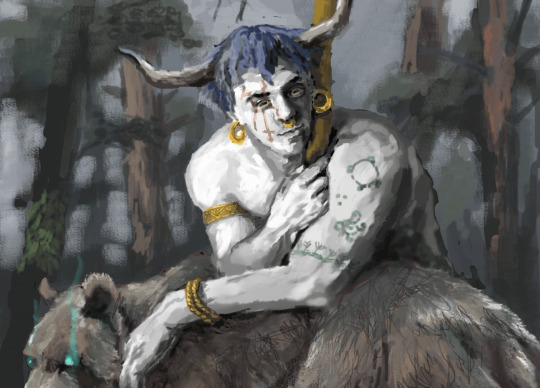
Veles by Milica Cvetic
All information about Volos besides the fact that it was an important god of cattle looks extremely shaky. There is a theory that he was an opponent of Perun. It is based on the correlation of Volos with the Baltic Vels and Velnyas, a spirit connected with the underworld and cattle, and the opponent of Perkunas the thunderer. However, it should be realized that the sources telling already about this character are rather late and of ambiguous authenticity.
When contrasting Volos and Perun, it is sometimes said that Volos was the earthly god of gold and the common people (apparently, farmers), and Perun was the heavenly god of war and the rulers' retinue. This idea is based largely on the text of the oath, which mentions both Perun and Volos, as well as gold and weapons: "let us be cursed by the God in whom we believe, Perun and Volos, the cattle god, let us be as yellow as gold, and let us be cut with our weapons".
But, first, there is no obvious distinction here. Secondly, gold is mentioned in the context of yellowing of the skin and speaks rather of disease. It would be more accurate to conclude that these were powerful gods ruling over life and death. Hair was indeed most likely associated with wealth, but expressed primarily in livestock . And the possession of wealth is not very peculiar to the "common people" who are usually poor.
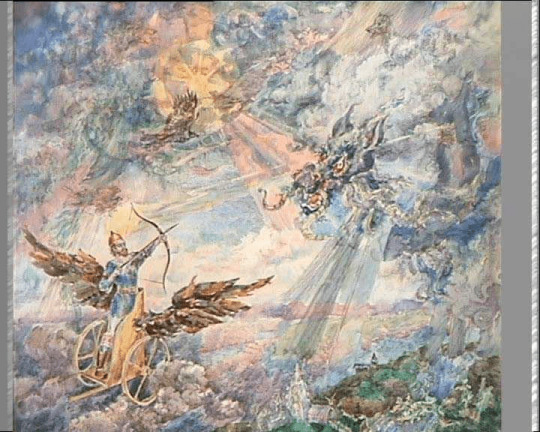
Perun fights with the serpent by A. Fantalov
The further development of the idea of the enmity between Perun and Volos turned him into a serpent, because the motif of the battle between the thunderer and the serpent is archetypal and is found in many peoples. The opposition of heavenly birds with earthly snakes, "creepers", in the culture of the Eastern Slavs occupies a very important place. But there is no reason to believe that it goes back to Volos.
"The Tale of Igor's Campaign" contains an indirect reference to Volos. Bayan, the legendary narrator, is called Veles' grandson. This can be understood as an epithet referring to his gift of words. And on this basis Veles is sometimes considered the god of poetry.

Veles by A. Klimenko
A more creative interpretation says that it refers to the gift of sorcery or volkhovanie. The idea of Veles as a god of wisdom, as well as many of his other attributes, entered popular culture from the "Book of Veles", a forgery from the 50s of the 20th century. For sure we can only say that there was such an important god Volos, and he had power over cattle, and thus welfare.

Veles by Andrey Shishkin
Svarog and Svarozhich
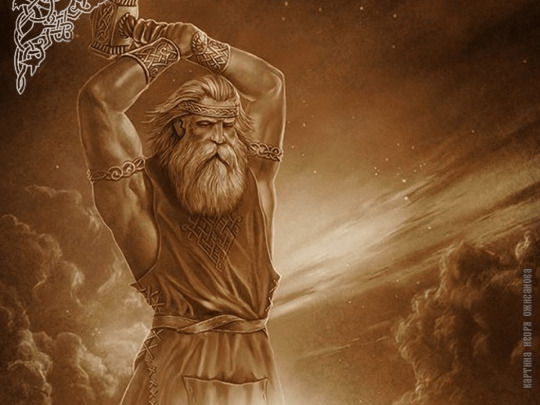
Svarog by Igor Ozheganov
Svarog is mentioned in the "Tale of Bygone Years", in the above described "Chronography" of John Malala. There, I remind, we are talking about the Egyptians, and the word "Svarog" is used to translate the name of Hephaestus (which is called, apparently, Khnum). Other sources mention Svarozhich, and it is probably the same character. Svarozhich was honored by the Western Slavs and was associated with fire. Whether he was honored in Ancient Rus is unknown.
Even if he was, a fire god is not always the same as a smith god, as Svarog is usually represented in popular culture. A fire god can be a god of hearth and sacrifice, a mediator between gods and humans, like the Indian Agni.
All others
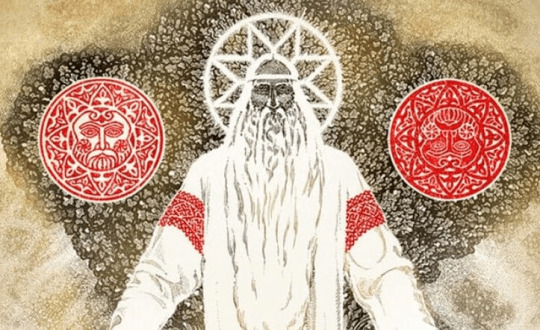
Rod by Maxim Kuleshov
For example, Trojan is the demonized emperor Trajan. His image is found in the folklore of the South Slavs, but it is more of a fairy-tale character. In "The Tale of Igor's Campaign" Trojan is also present, but there it is said about "time" or "trope" of Trojan, so it is not very clear whether it is about some ancient ruler-man, mythological character or deity, or whether there is some mistake of the copyist or translator.
It is also known as Dyj or Diy. Sometimes it is mentioned among the gods worshipped by pagans, but more often it is used to translate the name of Zeus in the retelling of ancient myths.
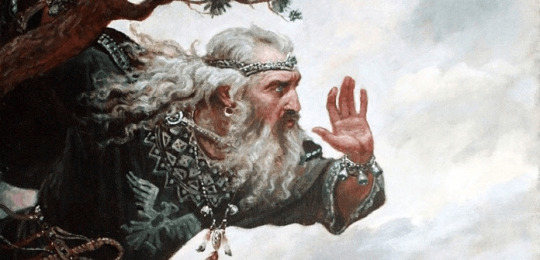
Pozvizd by Andrey Shishkin
Rod and the Rozhanitsy are not infrequently mentioned. But usually in the same lists, where in addition to gods it is said about the worship of vilas, ghouls, bereginas. Which, undoubtedly, were important characters in Slavic folklore, but they are rarely called gods, singling them out as a separate category (like nymphs, alves and other spirits). How far this is actually legitimate - the question is debatable, but this is the tradition. And it is quite possible that under Rod and Rozhanitsy meant the worship of ancestors and patron spirits.
The "Kyiv Synopsis", compiled very late, in the 17th century, gives an alternative list of idols erected by Vladimir. In addition to Perun, called the god of thunder and rain in human form, Volos, the god of cattle, as well as Pozvizd, Lado and Kupalo are mentioned.
All of them are associated with the book tradition: the authors of later sources, in imitation of the Greeks, invented gods themselves and then copied them from each other. Sometimes they relied on parallels with the same ancient mythology, sometimes - on grassroots folklore, folk rituals and festivals. And when odious researchers began to study such sources, Lado or Uslad, appearing in several later sources in the male gender, turned into the goddess Lada. That is, here we see layers and layers of fiction.
To such a mythology invented by scribes belong also Lel, Lelya and Polelya. The last three are chants like "la-la-la-la-la" deified in a desperate attempt to find some pagan gods.
Marena was hardly a goddess either, no matter how attractive her image in popular culture as a strong woman who commands winter and death. In fact, she is a ritual character, an effigy or tree burned when winter is spent, like Maslenitsa - or ritually mourned in later spring, like Kostroma. The latter connects it with the death-rebirth cycle: it is a metaphor for the sowing of seeds into the ground ("funeral") and their subsequent germination ("rebirth").
The second reason for the appearance of the image of the goddess of death is the similarity of the name Marena to the Latin root mor: "death", i.e. the fact that Christian authors and early researchers were engaged in folk etymology (this is when words are attributed a similar meaning because they sound similar, a headache for any linguist). But of course, the gothic ice maiden is beautiful.
Another popular image popularized by Gaiman's American Gods is Chernobog, the malevolent god of evil. The character is also very spectacular, moreover, most likely, really former god. It is described, however, in the Baltic Slavs, but in Russia and Ukraine there are toponyms referring to this name. We do not know much about him, except that because of the ominous name of Chernobog very much loved Christian authors, boldly writing him in the devils.
Often he is mentioned together with Belobog, his antagonist and embodiment of good. But in recent times, the opposition between Chernobog and Belobog has been attributed to the fantasy of authors impressed by Manichaeism (a dualistic religion that asserted that evil and good were equally powerful).
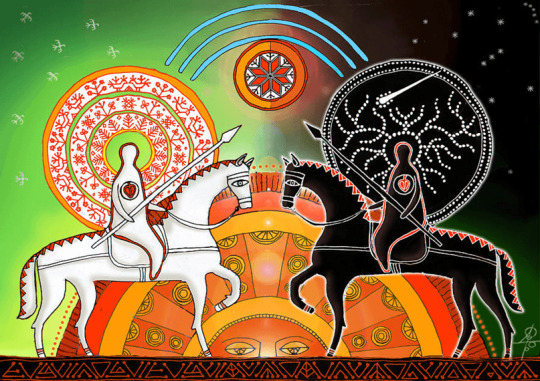
Chernobog and Belobog by Maxim Shukharev
As for Chernobog himself, if he was not invented by Christian authors, it is not a fact that he was such a villain. Black color does not always mean something bad, it can be associated, for example, with black soil - fertile land. It is not excluded that the black god could be called different characters depending on the area or specific idols made of black stone or wood.
Of course, it is a pity that we are not left with at least our own Edda to learn more about the gods worshipped by the Slavs in the territory of Ancient Rus. But this is not a unique situation - in many countries, ideas about the pagan past are also based on romantic speculations, controversial etymological constructions and Christian or Roman sources.
And if you want to learn more about mythological representations of Russians, Belarusians and Ukrainians - turn to the rich grassroots folklore, folk orthodoxy, fairy tales and songs. There you can find a lot of beautiful and interesting characters, images and themes that are undeservedly overlooked in attempts to find gods like those of the ancient Greeks.
Original by Maria Solntseva Translated by me :)
#slavic#slavic culture#slavic folklore#slavic folk#slavic mythology#folk#folklore#slavs#history#culture#history tag#mythology and folklore#mythology#slavic polytheism#slavic paganism#paganism#pagan#paganblr#diety work#ancient history#ancient rus#human history#polytheism#cultural history
26 notes
·
View notes
Text
Elements- Air 🌪
The Sun has now moved from grounded, sensual Taurus to fun-loving and social air sign Gemini! (I will be doing a whole post about Gemini season later this week). For now here’s a list of correspondences which embody the divine element of air.
Ruling Planets: Mercury, Jupiter, Uranus
Direction: East
Ruler of: Mind, Clarity, Wisdom. Knowledge, Logic, Abstract Thought, Wind, Higher Consciousness, Psychic Work, Intuition, Memory, Divnination
Time: Dawn
Season: Spring
Colours: Yellow, Gold, White, Light Blue, Lilac
Zodiac: Gemini, Libra, Aquarius (3rd, 7th, 11th Houses)
Tarot: Swords
Tools: Feather, Wand, Staff, Incense, Censer, Pen, Broom, Bell
Virtues: Intelligent, Practical, Optimistic
Vices: Impulsive, Frivolous, Easily Fooled
Crystals: Topaz, Amber, Citrine, Jasper, Agate
Metals: Tin, Copper
Plants: Acacia, Anise, Aspen, Clover, Frankincense, Lavender, Lemon Grass, Myrrh, Pine, Verbena, Yarrow
Deities: Amun, Pazuzu, Stribog, Sidhe, Njord, Aeolus, Vayu, Fujin, and many many others
#air#elements#magick#correspondences#wicca#pagan#religioun#gods#elemental magic#gemini#witchblr#witch
22 notes
·
View notes
Text
Air

Gender: Masculine
Used in spells: It’s one of the 4 or 5 elements and is used to cast a circle in the beginning of the rituals. This element has to do with intelligence, cognitive ability, your mind, communication, and getting along with people.
Air is a great element to use separate for spells that have to do with intelligence/cognitive ability and that are more short term in nature. Air is a much less stable element then, for example, earth. So it’s better to use it for short term goals/less serious spells. (If you are focusing on air and using it outside of the purpose of casting a circle).
What you can use to represent Air: Incense, Perfume (what I personally use), feathers, smoke, wand, fragrant flowers, mint, peppermint, azurite, turquoise
Planets: Jupiter, Mercury
Seasons: Spring
Zodiac signs: Gemini, Libra, Aquarius
Deities: Perun, Baal, Boreas, Zephyrus, Apheliotes, Stribog, Dogoda
Color: Yellow
36 notes
·
View notes
Text
Thoughts on Slavic Polytheism
I just needed to get some of my thoughts out on this topic so this may seem very unorganized and chaotic, but I hope to have better organized posts that are much more informative and stick to a single point, but I do not have the time for that currently with everything going on at university. The concerns I raise are found consistently in Western academia, “Slavic academia” (whatever that means), and of course on tumblr which pulls heavily on outdated materials because thats all they have access to. I am currently compiling a list of articles in English which I think may help clear some of the misunderstandings and offer actually credible/up to date sources, but you’ll have to wait for that.
Also, as a disclaimer, I am not an academic on Slavic polytheism or a professional on the matter (yet!), but these random musings come from years of personal research. And when I say years I mean years. But to just quickly state the biases I might have: I am practitioner of the folk religion of the Slavic peoples, but more specifically the Ukrainian branch of it. Most of my resources have focused on the Ukrainian flavor of the Slavic pre-Christian faith, but most definitely not exclusively as that would be impossible to get any sort of understanding of the faith without comparing it to my neighbors.
First and for most, Slavic polytheism has had influence from the Nordic and Germanic polytheisms, but it is no where the closest or most related. I see this mostly in imagery and how people conceptualize the deities. Thor and Perun are not two sides of the same coin, sure they might have similarities being both derived from an Indo-European source, but seeing Perun as a Slavic Thor is very much bad academia. Slavic polytheism and folklore has a whole load of connections to ancient Iranian polytheism. I would even venture to say that Slavic polytheism is a very interesting blend of Baltic and Iranian mythologies and folklores. This is not to say it is one and the same, but when looking into comparative studies these will offer the richest and most accurate comparisons.
We need to stop seeing Slavic polytheism in terms of Christianity and other institutionalized/state religions (Like Greek or Roman polytheism). Knyaz Volodymyr attempted to institutionalize the Slavic pantheon and failed, converting the people to Orthodoxy only a couple years after this attempt. His pantheon was not universal to Slavs. It pulled from various Slavic tribes and non-Slavic tribes and therefore is perhaps more representative of the elite’s conceptualization of the deities, and not of the common people.
Attempting to reconstruct the Slavic religion without recognizing ancestor veneration is impossible. This is the backbone of the entire religion. The deities were seen as the first ancestors, not like in Greek polytheism where the Gods are a different “species”, for a lack of a better term. We see this reflected in folklore about the Saints being the people’s ancestors, or naming the Moon as an ancestor.
(This concern is more pointed towards people who wish to worship the slavic gods: You can not worship Perun or Veles or Mokosh, etc. without worshiping ancestors. I mean you can, but you aren’t reconstructing the slavic faith, but rather implanting Perun into a, dare I say, New Age/Wiccan(?) structure/conceptualization of paganism.)
People need to start changing how they conceptualize the Slavic pantheon not as a rigid religion controlled by a state, like Greek or Roman polytheism, but rather look into folk religions like Vodou, and rely more on Folklore then on sources writing about the Slavic pre-christian faith through a Christian lens. Of course these few and far between sources can point us in a direction, but when reconstructing the “theology” of the Slavic faith it gives us close to nothing. What I mean is, these sources do not offer anything in terms of how the pre-christian slavs conceptualized the the cosmos, spirits and their gods.
I’m not even going to touch the embarrassing amount of fake gods propagated in academia and on tumblr. I tried making a post about this and failed because i didn’t even know where to start. And many gods are just mislabeled rather than being outright forgeries (I’m looking at you Svarog and Stribog). But please don’t say that every holiday name (Koliada, Kupala, etc.) are gods... and stop with Bilobog and Chernobog... I can’t take it anymore (sarcasm, I will fight you to my grave and then some more in the afterlife).
These ideas and theories are of course are based of my own research, and these ideas will continue to shift as more knowledge is brought to light. Also do not take this as gospel, this is mostly ramblings. When the Gods and ancestors allow it, I want to support these claims with sources so people can read them and decide for themselves. Would love for people to submit their own evidence and theories and claims, so we can have a discussion about the faith that means so much to us.
120 notes
·
View notes
Text
Stribog - Żmija’s guide to Slavic Gods

art by Maxim Aleksandrowicz Kuleshov
part one of my guide to slavic faith - basic problems
part two of my guide to slavic faith - main gods
As I am aware than reliable sources in English are not this easy to find, I decided to translate some notes I have from the “Mythology of Slavic People” by Aleksander Gieysztor - a book which is crucial for anyone who wants to really delve into the Slavic faith. It is quite academic and focuses greatly on linguistics, archeology, and folklore. Includes info from Strzelczyk’s Mity, podania i wierzenia dawnych Słowian as well.
Stribog - in Polish Strzybóg - is an east-slavic deity appearing in only a few sources, such as Primary Chronicle (Tale of Past Years, a chronicle telling the history of Kievan Rus) and The Tale of Igor's Campaign (an epic poem written in Old East Slavic)
- in Tale of Igor’s Campaign, winds are called “Stribog’s grandchildren” which led to the assumption that Stribog was, at least among other things, a deity of wind/air/sky
- the core “stri-” might come from Indo-European *ster, which also appears in latin verb sterno, -ere, meaning “to spread, to stretch out” but also “spread/scatter with, cast down something, bestrew with” - this not only brings more connotations with the skies and the wind, but also with the function of giving, casting down gifts, and blessing people, similarly to Dazbog.
- elevating winds to the status of a demon/spirit, a personified force, or even a deity is quite popular in Indo-European religions - however, in Slavic folklore, winds are usually assumed to be rather hostile, dangerous. there are spells and practices meant to chase these winds away - winds that are often an effect of rather malevolent actions of certain spirits/beings
- again, another proof of Stribog’s importance in the lives of Slavs - or even his cult - can be found in toponymy (the naming of places): we have a village Strzyboga in central Poland, Striboże lake and village Striboż in Rus, Striboc stream.
- his position is generally described as a deity of winds and riches; however, there are not enough sources to confirm whether he was a universally known deity for Slavs or if those were indeed his only roles.
- not a historical source by any means, but a nice little addition for those interested in Stribog: Żywiołak’s song “Latawce” about slavic air demons calls them “servants of Strzybóg”
if anyone has any more information and sources on Strzybóg, do message me - I have read most of what’s available in Polish and I am not even close to being satisfied.
żmija
#stribog#slavic#slavic mythology#rodnovery#gods guide#two posts on one day??? żmija have you lost your mind
184 notes
·
View notes
Text
The New York Times Jews have converted to Byzantine Christianity. No icons of demonic Moses or demonic Christ are allowed in their churches.
Although Christianity had spread in the region under Oleg's rule,[citation needed] Vladimir had remained a thoroughgoing pagan, taking eight hundred concubines (along with numerous wives) and erecting pagan statues and shrines to gods.[21]
He may have attempted to reform Slavic paganism in an attempt to identify himself with the various gods worshipped by his subjects. He built a pagan temple on a hill in Kiev dedicated to six gods: Perun—the god of thunder and war, a god favored by members of the prince’s druzhina (military retinue)"; Slav gods Stribog and Dazhd'bog; Mokosh—a goddess representing Mother Nature "worshipped by Finnish tribes"; Khors and Simargl, "both of which had Iranian origins, were included, probably to appeal to the Poliane."[22]
Open abuse of the deities that most people in Rus' revered triggered widespread indignation. A mob killed the Christian Fyodor and his son Ioann (later, after the overall Christianisation of Kievan Rus', people came to regard these two as the first Christian martyrs in Rus', and the Orthodox Church[citation needed] set a day to commemorate them, 25 July). Immediately after the murder of Fyodor and Ioann, early medieval Rus' saw persecutions against Christians, many of whom escaped or concealed their belief.[c]
However, Prince Vladimir mused over the incident long after, and not least for political considerations. According to the early Slavic chronicle, the Tale of Bygone Years, which describes life in Kievan Rus' up to the year 1110, he sent his envoys throughout the world to assess first-hand the major religions of the time: Islam, Roman Catholicism, Judaism, and Byzantine Orthodoxy. They were most impressed with their visit to Constantinople, saying, "We knew not whether we were in Heaven or on Earth… We only know that God dwells there among the people, and their service is fairer than the ceremonies of other nations."[23
0 notes
Text
Slavic calendar
January 1.-6. - Days of Veles (celebrated as wolf-days too) 6. - Days of the bull (bull means fertility, vol/bull as Volos/god of bulls) also on this day (with the south slavs) one should get water from a spring and wash in it or spell with it because water has special magick characteristics on this day. This day is also called Vodice and is a female celebration 8.- Day to visit your granmom (female velebration) 12.- st. Vlas day- assoc. with Veles. In some sources this is the day when Veles steals Peruns wife, so I think this is surely a day to feast, for its the beggining of the wheel. Evening between 19. And 20.- the gate to Nav is closed, everything gets back to normal order, the sun/Krijes in the sky is lit (this means the sun starts its life and young Svarog (called Dažbog) starts his wheel). 17.-18. - Moranas days 28. - on this day the ancestors were celebrated and the old Russians believed if one doesnt feast/offer on this day everything in their house will turn topsy-turwy.
February 1. - Gromnica/Svijetlo (only day of winter when there are storms with thunder and lightning) 2.- In some sources also Gromnica but in the south celebrated as Sretenje- day when Winter and Summer meet. 11.- Veles’ day Aprox.16.-20.- Horse days (ancestor worship) 20.- Triglav’s day Aprox. 23. -27. -Mouse days/ Zadušnice (ancestor worship)
March 9.- Vesna’s day called Strinenija in some sources (notice that there is also another Vesna day celebrated in the south later or maybe just set wrong dates) In the noth celebrated as the day one should invite birds (and spring) with making bread shaped as birds and let children play with it. Aprox. 14.-20.- Bijele poklade/Bijela nedjelja/ White week (ancestor worship and in the south days when the sun is born) Aprox. 20.- Maslenica (Spring equinox) 21.- Vesna’s day 22.3-3.4.- Vodena nedjelja/ water week (when water gets special magick features) 24.- Komoidetsi are the days od honouring the Bear-god (representing Veles) This day is tied to honey, since the Bear-god is the god of honey and honey making.
April 3.- Vodan’s day (Russian, god of water) 7. Karna’s day (ancestor worship) Goddess Karna is of Russian orgin and represents crying and wailing 14.- Simargl’s day or (in the south) Ognjenbog’s day Friday before Jurijevo-Biljni petak/ Herbal friday (Days when females pluck herbs, on those days thier characteristics are harsher and stronger, female celebration) 22.- Ljeljenik is Lada’s day, celebrated as the Slavic womans day 23.- Jurijevo (Jarilos day) in some sources it says 4.5. BUT NO THIS IS THE WRONG DAY TO CELEBRATE, THIS IS ORTHODOX/MODERN Sunday after Orthodox Easter- Krasnaja Gorka was celebrated with burning a Morana doll and with a woman singing spring songs with a red egg and bread in her hands.
May 1.- Živa’s day (day of the sun’s rerurn, when Veles’ rulement stops, Bijelobog rules over Chernobog and the gates of the underworld (Nav) are closed. With the dawn starts new life. Živa is a goddes that represents fire and its return. Fire and hotness are life, just like the sun. Also on this day we should honour our ancestors. Also in some sources called Rodonica when Rod is celebrated for the oncoming harvest. Aprox. 10. Or the nearest Friday- Mokoš proljetna/ Mokosh of spring is a day when one may not do any harm to earth, not even put a knife in the soil for mother eath is pregnant with life and new beginings. Aprox. 14.-21.- Rusalka week (female gathering and celebration with sacrifice to the Rusalkas- probably so they dont take any lives for the year) 20.-30.- Rites, honourings, sacrifices to Rod for the oncoming harvest. In some sources it is called Grudie Rosnoe and on these days there would even be human sacrifices in some parts of Slavic lands, wich shows its importance.
June 15.- Vidovdan/ Bijeli Vid/ Svetovid’s day 21.- Kupala (Summer equinox)
July 3.- Rememberance of Svetoslav the great (pagan king) 20.-Perun’s day
August 3 -Associated with Mokosh (female celebration) 7.- Day to honour Veles and Mokosh. This was called Medov spas/Zaziuki, it represented the end of honey making and ripening of fruits. NOTE: Around this time there were no definite honourings because everything ripens and every night/day is good for honouring and thanking. 15.- Stribog’s day 18.-Hors’ day (Russian) 19.- Nature’s turn-around (day when nature changes from summer to ripening fruit and vegetables) also on this day untill the 22. One should get herbs because they have magick/more effective characteristics, wich is called Međudnevnice.
September 3.- Honouring the people of Novgorod. On this day Dobrinja prevailed and cast down all their idols. 15.- End of haymaking 24.- Radgost’s day or Svarog’s day, in most sources the Autumn equinox was adressed as Svarog’s day but in one I found Radgost. It was probably that both of the deities were praised on this day or it changed trough time. All in all, we can say this day we celebrate the Sun whos light gives us our crops but also we need to share our wealth and welcome our guests and friends to share with them.
October 21.- Maslenica (either a mixup in the sources name or the real name for another celebration) celebrated with making a corn-doll 29.9.- 28.10.-Baltic feast of the dead. October was celebrated as Veles month, called “Walla Manes" and this month is reserved for ancestor worship. The last day (26.) Is called Dziady and is celebrated. Friday between 25. And 1.11.- Mokosh of Autumn, female celebration
November 8.- Start of evil spirit season, probably the time when Nav’s (underworld) gate is opened 21.- Morana days 26.-St. George day (Associated with Perun) on this day wolves are particulary dangerous
December 3.- Day of remembering Bogatyr Svatagor 6.- St. Nicholas day (associted with Veles), this is probably the contrast to Perun’s day in November 21.-Koledo (Winter equinox) 22.- Božić-Svarožić is celebrated in the south, probably the day when young Svarog (in other slavic lands called WHEN SMALL Dazbog) is born or his seed is planted to sprout to the real sun in spring.
16 notes
·
View notes